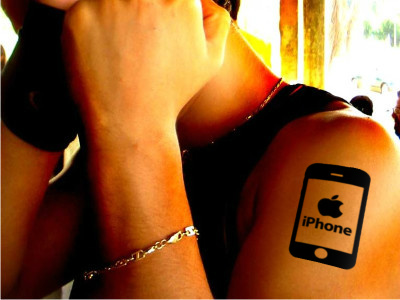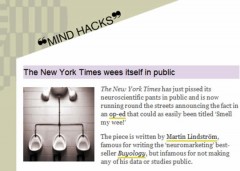Do You REALLY Love Your iPhone?

Lots of us say we love our favorite products. We love our Droid. We love our iPad. We love our comfy sweater. We love our bank. (Well, banks and airlines might feel the love a little less these days.) Last week, Martin Lindstrom, author of Brandwashed and Buyology, wrote an opinion piece in the New York Times that described his use of fMRI brain scans of subjects exposed to iPhone sounds and video.
…when they were exposed to the video, our subjects’ brains didn’t just see the vibrating iPhone, they “heard” it, too; and when they were exposed to the audio, they also “saw” it. This powerful cross-sensory phenomenon is known as synesthesia.
But most striking of all was the flurry of activation in the insular cortex of the brain, which is associated with feelings of love and compassion. The subjects’ brains responded to the sound of their phones as they would respond to the presence or proximity of a girlfriend, boyfriend or family member.
In short, the subjects didn’t demonstrate the classic brain-based signs of addiction. Instead, they loved their iPhones.
To those of us who know iPhone owners, the idea that at least some would experience an emotion like romantic love doesn’t sound far-fetched at all. But this short piece unleashed a firestorm of controversy and attacks from skeptical neuroscientists.
Is it true love?
Neuroscience post-doc Tal Yarkoni wrote a detailed criticism in the [citation needed] blog: the New York Times blows it big time on brain imaging. Yarkoni presents a lengthy analysis of how brain imaging can and should be interpreted, and concluded that what Lindstrom saw wasn’t “love:”
So the most appropriate conclusion to draw from the fact that viewing iPhone pictures produces increased insula activity is something vague like “people are paying more attention to iPhones”, or “iPhones are particularly salient and interesting objects to humans living in 2011.” Not something like “no, really, you love your iPhone!”
Indecent Exposure
 One commentary that didn’t pull any punches was at the Mind Hacks blog, which led with the rather unusual headline, “The New York Times wees itself in public.” The Times article clearly hit a nerve (that’s a figure of speech, not a neuroscientific claim):
One commentary that didn’t pull any punches was at the Mind Hacks blog, which led with the rather unusual headline, “The New York Times wees itself in public.” The Times article clearly hit a nerve (that’s a figure of speech, not a neuroscientific claim):
The New York Times has just pissed its neuroscientific pants in public and is now running round the streets announcing the fact in an op-ed that could as easily been titled ‘Smell my wee!’…
fMRI Mathematics
Fellow Austinite Russell Poldrack, Professor of Psychology and Neurobiology and Director of the Imaging Research Center at the University of Texas, summed up his conclusions with a headline equation:
NYT Op-Ed + fMRI = complete crap
WIRED for BS detection
Wired blogger David Dobbs (Neuron Culture) added to the list of colorful headlines with, “fMRI Shows My Bullshit Detector Going Ape Shit Over iPhone Lust.”
The Neuro-Empire Strikes Back
A gaggle of neuroscientists (is there a more appropriate collective noun?) put together a letter for publication in the NYTimes refuting the original editorial – here’s the uncut version.
My Neuro-Prescription
The unfortunate fallout from this controversy is that neuromarketing being pilloried as pseudoscientific claptrap will slow legitimate efforts in the field. And this sort of thing will continue as long as all of the serious work in the field is being done by private firms. The two related problems with this are:
- Neuromarketing companies that know what they are doing and producing great client results (assuming such firms exist) would be crazy to publish all of their data and the details of their methods and techniques.
- Neuromarketing firms that don’t know what they are doing (assuming such firms exist) can use the same “secret sauce” excuse for not publishing data.
The only solution to this conundrum is serious academic research using the same tools employed by private efforts. I just returned from the University of Akron’s conference on the Consumer Mind, and I’m excited that sooner or later we’ll start seeing peer-reviewed research from Akron and other institutions. (I’ll have a more detailed description of what’s going on in Akron soon!)
Academic research and some degree of transparency by commercial firms will go a long way to avoiding flaps like the current one. And instead of arguing about whether we “love” our iphone vs. finding it cool, fun, or whatever, instead let’s see if we can use imaging techniques to identify and refine the next amazingly popular product.
